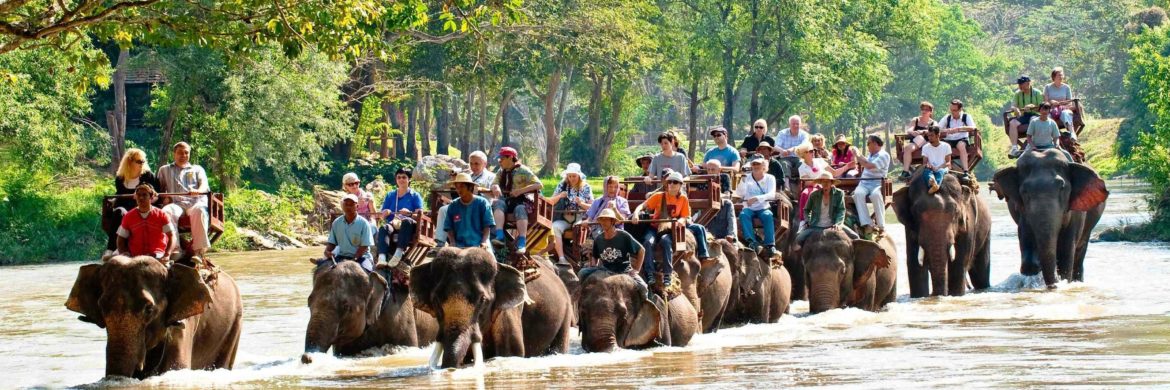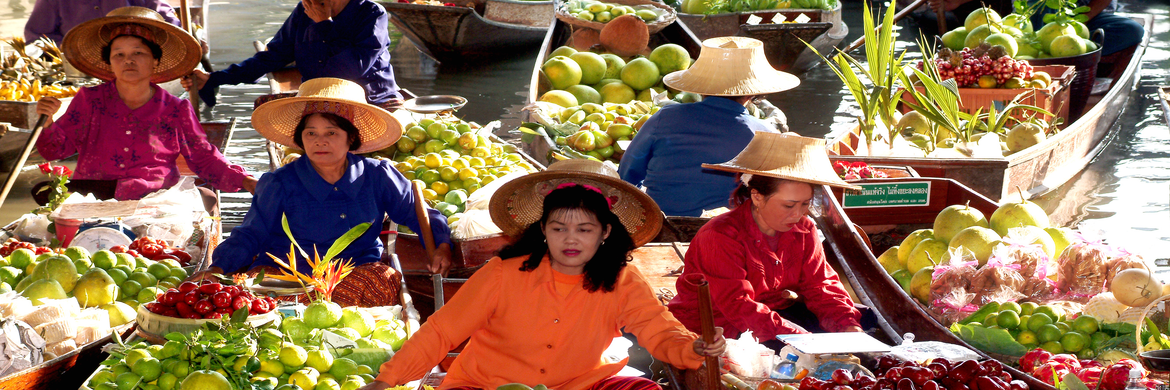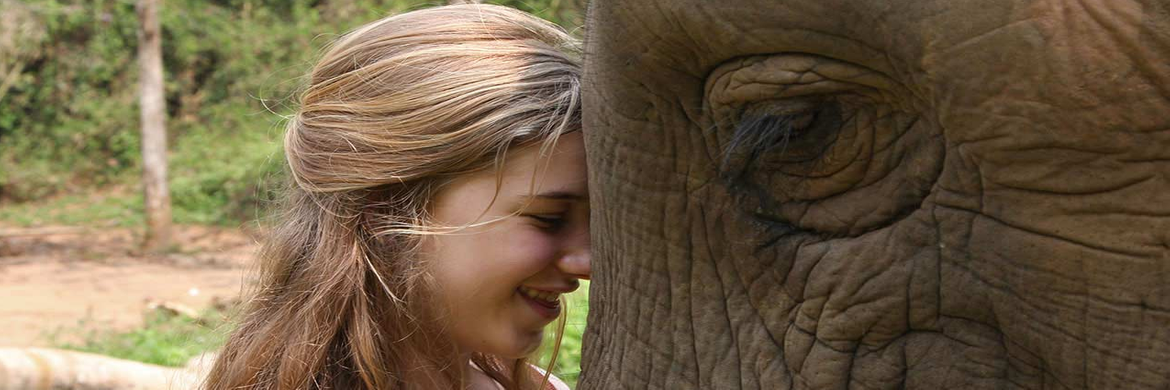Thailand Escapes
Thailand is a Southeast Asian country. It’s known for tropical beaches, opulent royal palaces, ancient ruins and ornate temples displaying figures of Buddha. In Bangkok, the capital, an ultramodern cityscape rises next to quiet canalside communities and the iconic temples of Wat Arun, Wat Pho and the Emerald Buddha Temple (Wat Phra Kaew). Nearby beach resorts include bustling Pattaya and fashionable Hua Hin.
Fascinating culture and art, gorgeous architecture, glorious beaches, five-star hotels and resorts, scintillating nightlife and some of the finest cuisine in Asia – Thailand has it all. Thailand is often called “The Land of Smiles” because the mostly Buddhist people are extremely affable and hospitable. The Kingdom of Thailand, formerly known as Siam, was one of the few Asian countries that was not colonized by the West. As such, its rich culture is largely free of European influence. Thailand is quite modern, relative to some of its neighbors (particularly in cosmopolitan Bangkok), and is one of Southeast Asia’s economic powerhouses, with first-rate hospitals and other international-level facilities.
A great deal of Thailand’s appeal is due to its geography. Thailand is blessed with two long, sinuous coastlines snaking their way down the gorgeous Andaman Sea and Gulf of Thailand. All that glitters is not just gold, but brilliant shades of azure and green accompanied by the swaying of palm trees amidst towering karst mountains and languid prismatic waters that make Thailand a tropical dream incarnate.
BANGKOK
Known as Krung Thep, which translates to “City of Angels,” Bangkok was established in the 15th century as a small trading post at the mouth of the Chao Phraya River. After facing the turmoil of Japanese occupation during World War II, Bangkok boomed in the 1960s and 1970s, as the United States came to rely on Thailand as a staging area for the Vietnam War effort. Today, Bangkok has blossomed into Thailand’s most populated city, with 12 million residents as of 2012. The city is rich with cultural heritage and plays a leading role politically, socially, and economically in the country as well as southeast Asia. The city offers a wide range of attractions to satisfy varied tastes, including temples, nightlife, shopping, museum, palaces, and much more. Must-see activities and sites in Bangkok include the poetically-named Wat Arun, or Temple of the Dawn, a beautiful, ornate structure overlooking the Chao Phraya; Wat Pho, home to a giant Buddha and perhaps one of the most renowned temples in Thailand; the Grand Palace, which once housed Thailand’s kings; and the famous floating markets, where merchants in canoes sell fresh, natural produce.
PHUKET
Derived from the Malay word bukit, or hill, Phuket was long known to European traders as Junk Ceylon, and a rich source of valuable tin. After an attack by the rival Burmese navy in 1785, which was repulsed by forces commanded by a local widow and her sister, Phuket rose to prominence as a regional administrative center, charged with running the southern provinces of Thailand. Today, Phuket is the largest island in Thailand, and sports fine beaches, constant sunshine, and an enviable proximity to a multitude of attractions and dive sites – among them the Similan Islands, Koh Phi Phi, and the limestone peaks of Phang Nga Bay. While Phuket was devastated by the Indian Ocean tsunami of December 2004, it has since repaired the damage, and, thanks to its tourism revenue, become the wealthiest province in the country.
KRABI
One of the oldest, continually inhabited places in Thailand, Krabi is thought to have been home to homo sapiens since 25,000 to 35,000 B.C. While the area suffered considerable damage during the devastating Indian Ocean tsunami of 2004, Krabi has since recovered – though tsunami evacuation signs are a common sight throughout its streets. Today, Krabi is best known for its surreal, finger-like limestone karst formations that sit on the edge of the cerulean Andaman Sea, alongside mangrove forests, coral, outlying islands, and lovely beaches. This natural wealth draws kayakers, adventurous rock climbers looking for an outdoor challenge, and travelers curious about the strange, otherworldly topography of the region.
CHIANG MAI
Founded by the ancient Lanna Kingdom in 1296, Chiang Mai was originally a heavily fortified citadel that stood as a bulwark against Burmese kingdoms and the Mongol Yuan Empire, which had conquered much of China and parts of Southeast Asia. While the Lanna kingdom would rule parts of Thailand for 500 years until the late 1700s, Chiang Mai was later abandoned and fell into a slow decline – which was reversed only in the twentieth century. Today, Chiang Mai is the cultural center of northern Thailand, and a thriving city that hosts a number of outstanding temples, which are complemented by some of the best outdoors activities in all of Thailand – due to its proximity to nearby lush rainforests and the mighty Mae Taeng River. Notable attractions include the Tiger Kingdom, where visitors can get up close with the big cats, and Wat Prathat Doi Suthep, a picturesque, beautiful mountain temple.
CHIANG RAI
Nestled in the heart of the Golden Triangle region, which encompasses the mountains of Laos, Myanmar, and Thailand, Chiang Rai is a land of tropical hills and mountains. In the past, the Golden Triangle was synonymous with the drug trade, as poppies were grown in the area and transported by a number of ethnic and tribal militias. Today, due to a series of major crackdowns, the Golden Triangle is considerably safer, and slowly gaining a name for itself through legal tourism rather than illicit smuggling. Standout attractions include the fun, fascinating Flight of the Gibbon, an intense, wildly fun zipline course; a journey up the Burma Road, which straddles the Myanmar-Thai border; and a series of high-mountain tea plantations. Visitors should note that the demographics of the area are also much more ethnically diverse than elsewhere in Thailand – and, as such, are a fascinating contrast to the rest of the nation. A significant minority of the population is composed of hill tribes, among them the Karen, Lisu, and Akha, as well as ethnic Chinese settlers.
KOH SAMUI
Most Asian countries with coastline experience at least part of their wet season from June to August, but Koh Samui is one of the few places we recommend visiting at this time of year because it is typically hot and relatively dry. Beautiful, fine sand beaches on the calm, warm Gulf of Siam and a wide array of water sports, including sailing, fishing, snorkeling, and boogie boarding are available, in addition to hikes through the rainforest, delicious Thai cuisine, and indulgent spa treatments.
AYUTTHAYA
For over 400 years, Ayutthaya was a major political, economic, and cultural powerhouse of Southeast Asia. Home to the eponymous kingdom, which traded with, among others, merchants from China, Vietnam, India, Spain, France, and Holland, Ayutthaya was perhaps the first, true Thai realm, holding sway over much of what is now modern-day Thailand. In 1767, the kingdom was sacked and burned by a rival Burmese army, and reduced to rubble. Today, the little that remains of Ayutthaya’s former glory takes the form of crumbling temples, such as Wat Maha That, or partial reconstructions, such as Wat Phra Si Sanphet. Happily, restorations and renovations are underway, and most, if not all, of Ayutthaya is open to the general public.
SIMILAN ISLANDS
Secluded and far off the beaten path, the Similan Islands lie on Thailand’s west coast, north of Phuket and Krabi. Set amidst the fluorescent turquoise of the Andaman Sea, the Similan Islands were declared a national park in 1982. The archipelago, comprising eleven islands (of which the eponymous Ko Similan is the largest), is in the process of being declared a UNESCO World Heritage Site. Fortunately, this natural treasure was spared damage from the 2004 tsunami, and remains a fantastic diving and snorkeling site, as well as an ideal location to hop from one island to another. The best months to visit are March and April, and the high season runs from December through April. Please note that between May 16th to November 15th, the park is closed.
- Partake in a Lanna wedding – Don traditional dress and join in a typical northern Thai wedding at a local family’s house.
- Connect with spiritual Thailand – Witness monks’ chanting rituals, be blessed in a spiritual ceremony and make offerings at pagodas to connect with Thai culture.
- Travel in Style – Enjoy private excursions designed for two, stay in romantic luxury hotels and dine at Thailand’s best tables.
- Shopping at the local markets – Enjoy some retail therapy at Thailand’s liveliest markets such as the Asiatique Night Market and Warorot Market
- Explore Chiang Mai by Segwa – Glide through Chiang Mai’s most historical spots via Segway
- Interact with elephants – Get up close with Thailand’s sacred animal and learn how to approach them with the guidance of a mahout.
- A look at Buddhist culture – Witness the daily life of monks and partake in the daily almsgiving in exchange for a private blessing.
- See Thailand’s most revered temples – View the most beautiful temples in Thailand including Wat Niwet Thammaprawat, Wat Mahathat and Wat Rong Khun.
- Cruise down majestic rivers – Take in the breathtaking sights of Chao Praya River, Mekong River and Mae Ping River.
- Camp in style – Spend three unforgettable nights at the luxurious Four Season’s camp and be pampered with nightly sundowners and wine and cheese tastings.
- Unique dining experiences – Have an option to dine at the elephant camp in true safari style and relax with after-dinner drinks and stargazing.
- Trek with elephants – Learn first hand from a mahout on how to bond and communicate with an Asian elephant and practise the commands on a trek with these gentle giants.
- Deep dive into Thai culture – Explore historical temples, taste Thai cuisine, learn how to prepare northern Thailand dishes, and shop at the busy markets.
- Experience ultimate relaxation – Slip in some quality relaxation time by doing yoga at the beach, getting an aromatherapy massage, and a meal at the highest al fresco restaurant in Bangkok.
- Muay Thai lesson with a champion – Learn Muay Thai from a renowned Muay Thai fighter.
- Taste Bangkok’s best dishes – Visit the trendiest culinary destinations and try out the best cuisines in Bangkok.
- Explore historical Bangkok – Go around some of Bangkok’s most historical sites such as the Royal Grand Palace and the Emerald Buddha.
- Join a meditation course – Take a half-day Buddhist meditation class, learning from a Thai monk at one of Bangkok’s tranquil temples.
- Indulge in unique spa treatments – Enjoy a one-hour ‘float’ session, removing all sensory input to help clear the mind and relax the body.
- Retreat on tropical beaches – Spend a week on the beach, staying seaside in Hua Hin and then a top spa resort on Koh Samui.
- Historical temples of Thailand – Visit the magnificent temples from the White Temple of Chiang Rai to the silver-adorned temple of Wat Srisuphan in Chiang Mai.
- Up close and personal with elephants – Put on a mahout’s attire, learn the basic commands and feed and bathe the elephants in the river.
- Explore ancient caves – Appreciate the natural beauty of Thailand with visits to the Prakarang Coral Cave and the 1.5 kilometre Tham Lod Cave.
- Traditional arts and local produce – Learn and mimic the fundamentals of traditional thai puppet theatre and local produce with visits to vineyards.
- Ancient cities of Sukhothai and Ayutthaya – Visit the ancient cities of Ayutthaya and Sukhothai and learn about the rise and fall of the old empires of Thailand.
- Exquisite visits to local’s homes & cuisine- Taste northern Thai food along the way including a visit to a local’s home to tour their organic and share secret recipes of the family.




